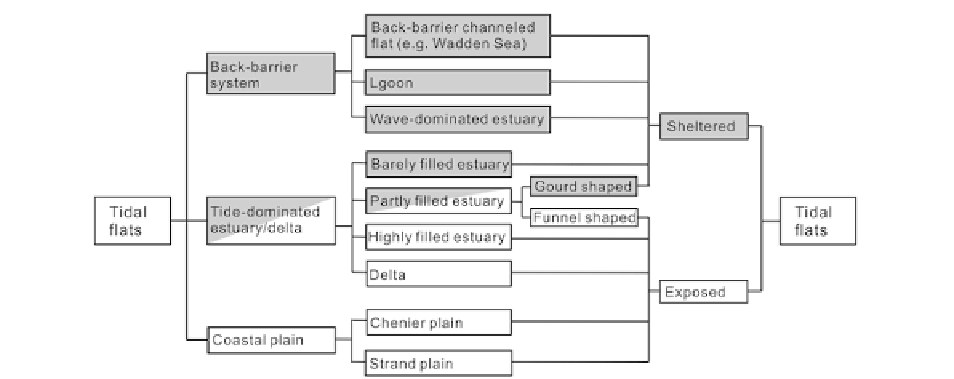Geology Reference
In-Depth Information
Fig. 9.1
Classifications of tidal flats and their relationships
completely exposed to the coastal sea or the open
ocean (Fig.
9.1
). Rudolf Richter, a German paleonto-
logist, began the first systematic geologic studies of
tidal flats along the German North Sea coast in the
early 1920s. These studies were not only well carried
on by his successors at the Senckenberg Institute but
also rapidly spread out to the Netherlands, UK, and
North America after the World War II (Ginsburg
1975
;
Middleton
1991
; Klein
1998
). Increased interest in
fossil tidal deposits ignited comparative studies, and
criteria for recognizing tidal-flat deposits were sum-
marized: (1) cross-bedding with evidence for current
reversals, like herringbone cross-stratification, reacti-
vation surfaces, and mud couplets/drapes; (2) tidal
bundles with evidence for tidal rhythms, e.g., diurnal,
semilunar, and lunar cycles; (3) flaser and lenticular
bedding in fining-upward successions (Middleton
1991
; Nio and Yang
1991
).
The well-known criteria for tidal-flat deposition
obviously bear their regional background of the
Wadden Sea and the Bay of Fundy (e.g., Klein
1985
;
Dalrymple
1992
; Boggs
2005
), that are classified as
sheltered tidal flats (Fig.
9.1
). The Wadden Sea is the
tidal-channel-flat complex separating the barrier island
system from the mainland, which in turn connects with
the North Sea through the tidal inlets between each
two barrier islands (Ginsburg
1975
; Davis et al.
1998
).
In the Bay of Fundy, tidal flats occupy the innermost
part of the estuary, separating the outer erosion zone
with elongate sand bars (Dalrymple et al.
1991
). The
sheltered tidal flats are characterized by the presence
of tidal sand bodies (linear shoals or bars) at the lower
intertidal zone or the subtidal zone, and delicate tidal-
channel systems cutting into the flats. Lateral migra-
tion of channel bars and/or high sedimentation rate in
the sheltered settings are potential to produce rhythmic
tidal-bundle successions or cyclic tidal rhythmites
(Boersma and Terwindt
1981
; Nio and Yang
1991
;
Dalrymple et al.
1991
; Dalrymple
2010
).
Over the past three decades, a deep passion has
been intrigued toward finding tidalites with cyclic
variations in bundle/lamina thickness, encoding tidal
periodicities of neap-spring cycles, diurnal, fortnightly,
and other longer inequalities (e.g., Boersma and
Terwindt
1981
; Kvale et al.
1989
; Dalrymple et al.
1991
; Tessier
1993
; Williams
1997
; Coughenour et al.
2009
). The quantitative features (tidal periodicities) of
the strata are significantly important in ascertaining
their tidal origin, considering that most of qualitative
features like flaser and lenticular bedding are not
exclusive from non-tidal environments. The neap-spring
periodicity of cyclic tidal rhythmites is also highly valued
for reconstruction of the history of tides and lunar orbit
throughout the geologic time from the Archean to the
present (Coughenour et al.
2009
). It is, however, note-
worthy that the preservation of cyclic tidal rhythmites
requires special conditions like sheltered areas with
high sediment and accommodation-space availability

